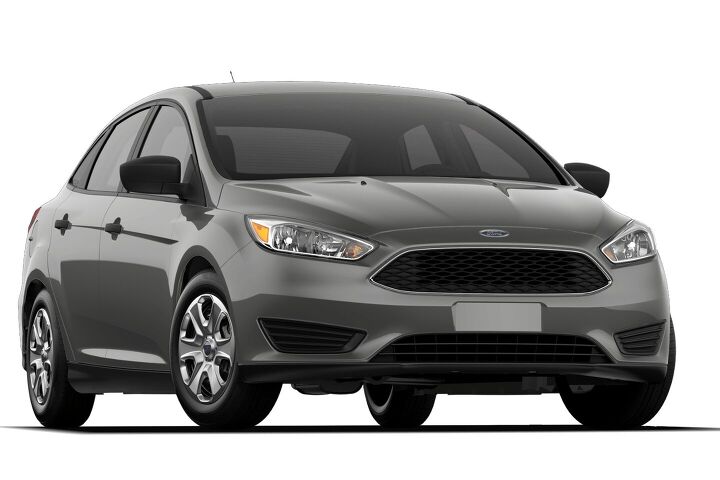Fourth-generation Ford Focus Goes Upmarket, Spawns an Active Variant Of Course
Rarely does one hear an automaker point out that the next generation of a popular product is headed downmarket.
Even when a vehicle is repositioned in a lower end of the market, “downmarket” is the last word you’re going to hear out of an auto executive’s mouth. Instead, automakers up the value quotient, cater to the demands of discerning buyers, or find new production efficiencies we can pass on to the customer.
More often, automakers tout their new product as a move upmarket. So it is with Ford Motor Company’s fourth-generation Focus, according to Jim Farley, formerly of Ford of Europe and current head of Ford global markets. “It goes upmarket in exactly the same way as the new Fiesta,” Farley says.
Also like the new Fiesta, the 2019 Ford Focus will spawn an Active variant. Subaru Crosstrek here we come?
How Ford breaks down the Focus lineup in the United States, of course, is yet to be seen. While Ford of Europe will continue to build the Focus in Saarlouis, Germany, America’s Focus will sail across the Pacific from China.
Just as Ford’s European decision with the latest Fiesta concentrates on more premium content bears no resemblance to Ford’s plans for the Fiesta in North America — the old Fiesta is continuing here for now; the new Fiesta isn’t destined for America — so too Ford’s methodology for Europe’s Focus could differ from the Focus mission in America.
Farley acknowledges that a move upmarket will result in “slightly lower” Focus sales in the future, but that’s a sacrifice Ford is willing to make in order to secure its grip on the C-segment. In Europe, Automotive News says, the Focus is now the fourth-ranked vehicle in the category, not just behind the Volkswagen Golf and Opel Astra but the Golf-related Skoda Octavia, as well.
Stateside, the aging Focus has seen its status plunge as consumers back gradually back away from cars. The Focus is outsold by five compact cars: Civic, Corolla, Sentra, Cruze, Elantra. Focus sales are down 12 percent so far this year in a category that’s down just 4 percent. Its market share fell from 12 percent in 2012, to 11 percent in 2013, to 10 percent in 2014, to 9 percent in 2015, to 8 percent in 2016 and so far in 2017.
Farley believes “urban utility products” are an area where the Ford brand’s European division is particularly strong. The degree to which that message crosses the Atlantic will be discovered as Americans reject or accept the new EcoSport.
As for moving the America’s Focus upmarket, it’s a strategy that would likely involve axing models such as the Focus S. The 2017 Focus S sedan is currently marked down to a decidedly downmarket $14,400.
Across the pond, Ford reincarnated the Vignale name with a concept that previewed the Focus CC hardtop convertible. To date, while the Vignale name has been used on top-spec versions of vehicles such as the Mondeo, Kuga, Edge, S-Max, and now the Fiesta, the Focus has not yet received the luxury designation.
[Images: Ford Motor Company]
Timothy Cain is a contributing analyst at The Truth About Cars and Autofocus.ca and the founder and former editor of GoodCarBadCar.net. Follow on Twitter @timcaincars and Instagram.
More by Timothy Cain
Latest Car Reviews
Read moreLatest Product Reviews
Read moreRecent Comments
- Daniel J Cx-5 lol. It's why we have one. I love hybrids but the engine in the RAV4 is just loud and obnoxious when it fires up.
- Oberkanone CX-5 diesel.
- Oberkanone Autonomous cars are afraid of us.
- Theflyersfan I always thought this gen XC90 could be compared to Mercedes' first-gen M-class. Everyone in every suburban family in every moderate-upper-class neighborhood got one and they were both a dumpster fire of quality. It's looking like Volvo finally worked out the quality issues, but that was a bad launch. And now I shall sound like every car site commenter over the last 25 years and say that Volvo all but killed their excellent line of wagons and replaced them with unreliable, overweight wagons on stilts just so some "I'll be famous on TikTok someday" mom won't be seen in a wagon or minivan dropping the rug rats off at school.
- Theflyersfan For the stop-and-go slog when sitting on something like The 405 or The Capital Beltway, sure. It's slow and there's time to react if something goes wrong. 85 mph in Texas with lane restriping and construction coming up? Not a chance. Radar cruise control is already glitchy enough with uneven distances, lane keeping assist is so hyperactive that it's turned off, and auto-braking's sole purpose is to launch loose objects in the car forward. Put them together and what could go wrong???




































Comments
Join the conversation
I'll buy a Focus Crosstrek ST tomorrow. So that's one.
Are we effectively getting a gen2 Chinese Escort? I'd be curious to see what the thing might look like in the flesh.